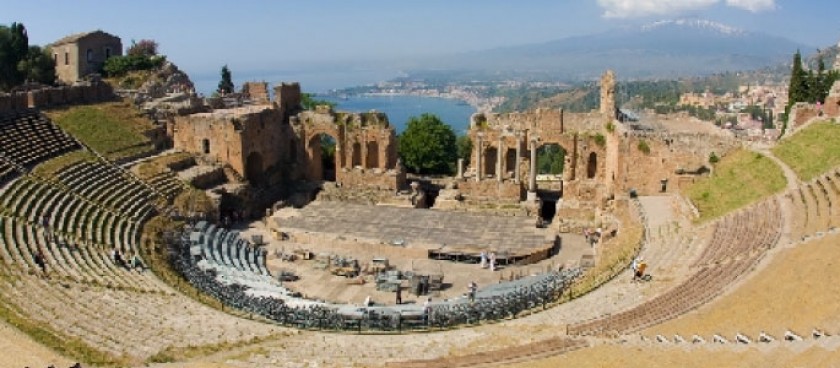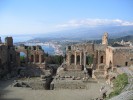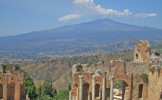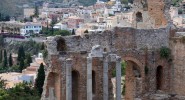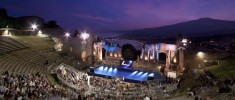- #IT36
- Via del Teatro Greco, 1, 98039 Taormina ME, Italy
- +39094223220
- http://www.parconaxostaormina.com/
- Prices*:
From 10€ - * - opening and closing times as well as entrance prices, are subject to alterations without notice. Visitors are advised to check before visiting.
- 37.8525462, 15.2921665 Copy to clipboard Copy
-
#History , #Architecture
The ancient theatre (the teatro greco, or "Greek theatre") with a diameter of 120 metres (390 ft) (after an expansion in the 2nd century), this theatre is the second largest of its kind in Sicily (after that of Syracuse); it is frequently used for operatic and theatrical performances and for concerts. The greater part of the original seats have disappeared, but the wall which surrounded the whole cavea is preserved, and the proscenium with the back wall of the scena and its appendages, of which only traces remain in most ancient theatres, are here preserved in singular integrity, and contribute much to the picturesque effect, as well as to the interest, of the ruin. From the fragments of architectural decorations still extant, we learn that it was of the Corinthian order, and richly ornamented. Some portions of a temple are also visible, converted into the church of San Pancrazio, but the edifice is of small size.
One view is that the word Etna is from the Greek αἴθω (aithō), meaning "I burn", through an iotacist pronunciation. Another view is that the name is derived from the Phoenician word attuna meaning "furnace" or "chimney". In Classical Greek, it is called Αἴτνη (Aítnē), a name given also to Catania and the city originally known as Inessa. In Latin it is called Aetna. In Arabic, it is called جبل النار Jabal al-Nār (the Mountain of Fire).
It is also known as Muncibeḍḍu in Sicilian and Mongibello or Montebello in Italian (the Italian word literally means "beautiful mountain"). According to another hypothesis, the term Mongibello comes from the Latin Mulciber (qui ignem mulcet, "who placates the fire"), one of the Latin names of the Roman god Vulcan.[citation needed] Another theory is that Mongibello came from the Italian word monte plus the Arabic word jabal, both meaning "mountain."
Today, the name Mongibello is used for the area of Mount Etna containing the two central craters, and the craters located southeast and northeast of the volcanic cone.
The name Mongibel is found in Arthurian Romance, as the name of the otherworld castle (or realm) of Morgan le Fay and her half-brother, King Arthur, localised at Etna, according to traditions concerning them derived from the stories told by the Breton conteurs who accompanied the Norman occupiers of Sicily. What were originally Welsh conceptions concerning a dwarf king of a paradisal, Celtic underworld became attached to the quasi-historic figure of Arthur as "Ruler of the Antipodes" and were then transplanted into a Sicilian milieu, by Bretons impressed by the already otherworldly associations of the great, volcanic mountain of their new home. Mediaevalist Roger Sherman Loomis quotes passages from the works of Gervase of Tilbury and Caesarius of Heisterbach (dating from the late twelfth century) featuring accounts of Arthur's returning of a lost horse which had strayed into his subterranean kingdom beneath Etna. Caesarius quotes as his authority for the story a certain canon Godescalcus of Bonn, who considered it a matter of historical fact of the time of Emperor Henry's conquest of Sicily circa 1194. Caesarius employs in his account the Latin phrase in monte Gyber ("within Etna") to describe the location of Arthur's kingdom.
The Fada de Gibel of the Castle of Gibaldar (Fairy of Etna) appears in Jaufre, the only surviving Arthurian romance in the Occitan language, the composition of which is dated to between 1180 and 1230. However, in Jaufre, while it is clear from her name that the fairy queen in question is Morgan le Fay, the rich underworld queendom of which she is the mistress is accessed, not through a fiery grotto on the slopes of Etna, but through a 'fountain' (i.e., a spring) – a circumstance more in keeping with Morgan's original watery, rather than fiery, associations, before her incorporation into the folklore of Sicily. For another Sicilian conception of the fairy realm or castle of Morgan le Fay – see Fata Morgana (mirage) re. an optical phenomenon common in the Strait of Messina.
